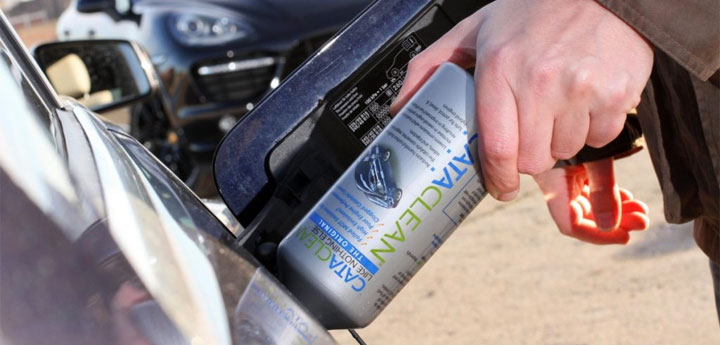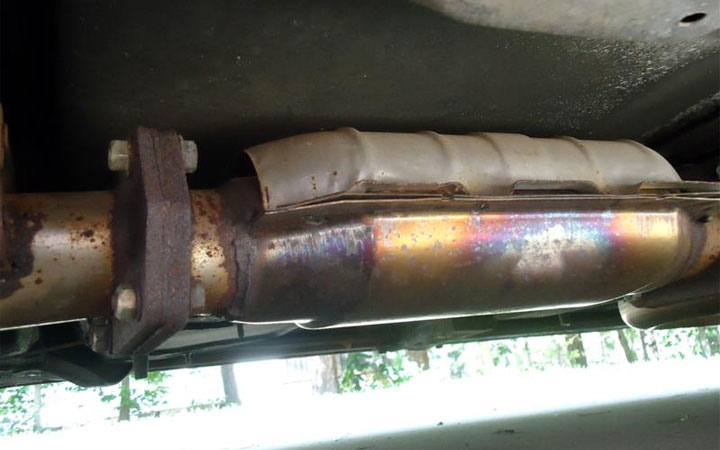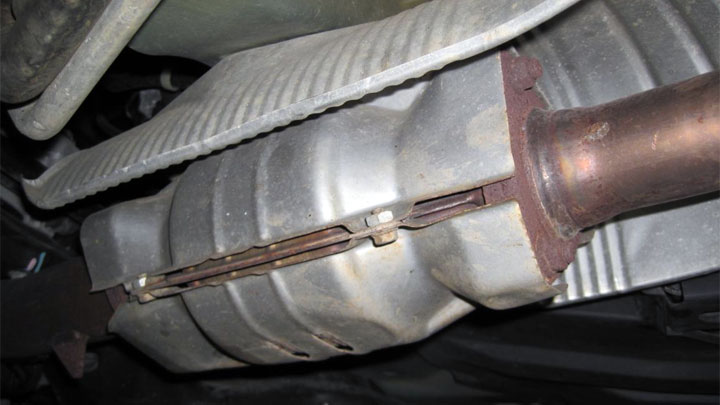Last Updated on October 24, 2022
If your vehicle has a working catalytic converter, it drastically decreases pollution and your carbon footprint. Catalytic converters turn carbon monoxide, hydrocarbons, nitrogen oxides, and other exhaust engine emissions into less harmful compounds, so they don’t hurt you or the environment.
To keep your car eco-friendly and running in optimal condition, you should know when and how to clean a catalytic converter.
What Causes a Catalytic Converter to Clog?
Over time, catalytic converters accumulate carbon deposits that reduces their efficiency. This is usually due to running a rich air-fuel ratio for too long. When this happens, your vehicle will show symptoms like:
- P0420 error code saying the vehicle’s computer detects a catalytic converter issue
- Exhaust fumes that smell like rotten eggs
- Reduced engine performance and acceleration
- Black exhaust smoke
- High temperatures under the vehicle
In most cases, cleaning the catalytic converter will also clear the P0420 code and the other symptoms. If you’d like to do the cleaning yourself, you can use one of two methods. One involves taking out the converter first, while the other does not.
Before we get into how to clean a catalytic converter, you can avoid these causes of catalytic converter clogging:
- Driving on bumpy roads breaks the ceramic catalyst honeycomb within the catalytic converter. The broken pieces can clog the system.
- Oil or antifreeze can leak into the exhaust system. When heated, the leak turns into thick exhaust fumes and soot that clog it. A leak can occur due to the vehicle’s age, broken seals, irregular servicing, or adding too much engine oil.
- Driving only short distances won’t get your catalytic converter hot enough to burn the engine hydrocarbons that enter it. These hydrocarbons will accumulate until they clog the system.
Can a clogged catalytic converter be cleaned? Yes, and we’ll help you save you money and time by showing you two ways to do it yourself.
See Also: DTC P0430 (Catalytic Convertor Issue)
Cleaning Method #1 (Without Removing)

Our first method for cleaning a dirty converter doesn’t require taking it apart or getting dirty and is cheap. This method also cleans your exhaust system, as well as your fuel system and oxygen sensors.
That said, this technique won’t work if the exhaust system is too dirty or you have a broken catalyst honeycomb.
To verify that this cleaning method will work for you, tap the converter with a mallet or wrench. Hit it hard enough to rattle it, but not so hard that you dent or break it.
If you hear rattling on the inside, you may have broken components or heavy sediments, which you can only fix by removing and cleaning the converter.
If you don’t hear any strange sounds, proceed with the following steps:
- Get some fuel and enough catalytic converter cleaner. Buy some fuel in a can and a good quality catalytic converter cleaner compatible with your vehicle. Some cleaners only work with diesel or gasoline engines, while others work with both.
- Pour the cleaner into your fuel tank. The cleaner’s label will have all the instructions you need regarding quantity to pour and how much fuel you should have in the vehicle.
- Take a drive. After adding the solution, start your engine and drive your vehicle. Driving will circulate the cleaner to clean your exhaust system. The cleaner’s label will state how long to drive for the best results.
We recommend driving with the RPM over 3000 to get the catalytic converter hot enough to burn out any clogs and residue.
With an automatic transmission, it’s a good idea to shift it into “Sport” mode or the like. With stick shifts, simply keep it in each gear a bit longer before shifting to the next gear.
Keep an eye on your vehicle’s temperature gauge to make sure it doesn’t overheat. If the cleaning process succeeds, you’ll notice less exhaust smoke, quicker acceleration, and fewer instances of engine misfires.
Related: How to Use Cataclean (Correctly)
Cleaning Method #2 (Removing It)

If the first method doesn’t deliver the desired results, then the dirt in your exhaust system requires removing the catalytic converter to clean it.
The process is straightforward with the right knowledge and tools but as with other exhaust components that are exposed to the elements, loosening the bolts is usually the toughest part of the task.
To start, you’ll need:
- Automotive degreaser
- A large container to soak the converter
- Penetrating oil, such as B’laster or WD-40
- Floor jack
- Jack stands
- A wrench that matches the converter’s bolts (or better yet, an impact wrench)
- Oxygen sensor wrench
- Pressure washer
Once you have everything you need, follow these steps:
- Let the vehicle’s exhaust system cool down before you begin.
- Jack the car up until it’s high enough to slide under with ease. Use the jack stands to keep the vehicle in position.
- Remove the oxygen sensor(s) with the oxygen sensor wrench.
- Find the converter and apply penetrating oil to loosen the bolts. If the catalytic converter is welded on or attached to the turbo, let a professional mechanic do the cleaning.
- After undoing the bolts, remove the converter and inspect it. A loud rattle when you shake it means its internal components are in pieces, and you need a new catalytic converter.
- If there’s little to no rattle, clean the body of the converter, then pressure wash its inside on low settings.
- After pressure washing the inlet and outlet pipes, fill a container with hot water and degreaser.
- Soak the converter in hot water and degreaser solution for no more than an hour.
- After the soak, rinse the unit with the pressure washer set to low, then let the unit drain until it’s dry.
- Once the system is dry, reinstall it and the oxygen sensor(s). Then take the car for a drive to see if it improves.
Does Cleaning Always Work?
If you don’t see improvements after cleaning the catalytic converter with either method, you need to get a replacement converter. Getting a replacement is expensive, but it keeps your vehicle legal and efficient.
Also, cleaning might not work if you have an internal oil or coolant leak. These areas will keep leaking into the hot converter and cause thick smoke and soot that clogs the system. Signs of leakage include breaks in valve seals, damaged piston rings, or crankcase ventilation blockages.
See Also: P0141 Code (What it Means)
What NOT To Do
To avoid damaging your catalytic converter during cleaning, avoid the following:
- Soaking the component in grout-eating gel, bleach, or similar corrosive chemicals that can damage the catalyst
- Pouring paint lacquer or thinner in your gas tank
- Using a catalytic converter that’s incompatible with your vehicle
- Trying to saw off a welded catalytic converter yourself, as you’ll damage the vehicle or hurt yourself
Use these methods to help you learn how to clean a catalytic converter yourself. If you have any questions, ask us in the comments.





Try soaking it in pure vinegar. It eats the carbon. Just cover in a tube of it over night and rinse out in the morning. Yoill be able to see through each tiny hole again no problem.
Using lacquer thinner in your gas tank good or not good ? I’ve been told yes and NO
I certainly wouldn’t. I only put gas in my gas tank, maybe a fuel additive for a specific purpose on rare occasion.
OK, I`m planning to remove converter and preheat it at high temperature by heater gun without soak and rinse. The aim of this operation is to remove all solid deposits such as carbon, soot, high molecular mass solid compounds, wax and all hydrocarbons in oxygen (air) conditons. During oxygenation deposits converts into CO, CO2, H2O.
What is the risk of catalytic converter damage during this process?
Put the catalystic convertor in a self cleaning oven to burn out the carbon? 🙂
i have the same problem with my Isuzu Crosswind I have spent a lot to remedy this but to no avail.. Now at least I have an idea where the problem is coming fron – MANNY THANKS to your channel more powee and regards please keep safe always
What about a lye solution & pressure wash? — I don’t think it can react with anything in there since its not an acid.
If you live in a state without emissions testing, just pull the cat and straight pipe it.
Straight pipe is dangerous for the driver, other people and the environment.
Unleaded Gasoline is 300% more toxic than leaded Gasoline.
As a driver do you want to breathe toxic fumes that will enter in your vehicle since there’s no catalytic converter?
Rattling noise coming out from cat. Is it possible to clean and use without replacing new one?
Unlikely, but you’ll have to drop the catalytic converter and inspect it to know for sure. Sometimes the internal honeycomb element comes loose and can rattle. When this happens, you risk a clog by not replacing the catalytic converter, because the element can be lodged the wrong direction and restrict flow.
I get code P0430 on my 2008 Nissan Frontier SE V6 4.0L. I changed downstream Bank 2 02 sensor per OBDII reading. Truck needle doesn’t move at idle in park or in gear, good power and no smell, burning of oil or smoking. I’ve put Catacleaner in twice and ran high octane gas through with two tank fulls. I’ve cleared the code but after driving 40-50 miles Service Engine Soon light comes on and when reading with OBDII the P0430 codes pops up again. Any thoughts or ideas what might take car of this? I also added some Bar’s Stop leak into my oil to seal up any possible leaks I can’t see. Any help is greatly appreciated.
Your catalytic converter may just need replacement. I’d take it to a shop and have them determine if that will be necessary.
2005 Nissan Frontier king cab 4.0 V6. P0300 (multiple cylinder misfire). Replaced all plugs, coil packs, all injectors and bank 2 fuel injector pressure dampener (didn’t realize there was one for each fuel rail). When none of this worked to clear my blinking check engine lightI pulled my exhaust system. The bank 2 primary cat (passenger side) was comepletely gone. Not only could I see light, I could read a book looking through it. 😂🤣😭
When I dropped the bank 2 secondary cat I found out what happened to the honeycomb in the primary cat. After dumping out as much of the clogged cat as I could, I soaked it in soapy water for 36+ hours, I forced 140 psi air through it to get it as dry as I could. Sprayed it down with the B12 aerosol let it soak about and hour. Rinsed it as best I could and repeated the 140 psi air dry. Then I took the torch to it for about 30 minutes. Max temp reading when done was about 360 degrees Fahrenheit. I can see some daylight through it. Do I stand a chance or should I just bust out all the honeycomb and reassemble. As soon as I can afford to replace the 2 cats I will, I just need my truck back on the road. 😔
Wow, nice work. She’ll probably run a lot better now that you cleaned out that cat.